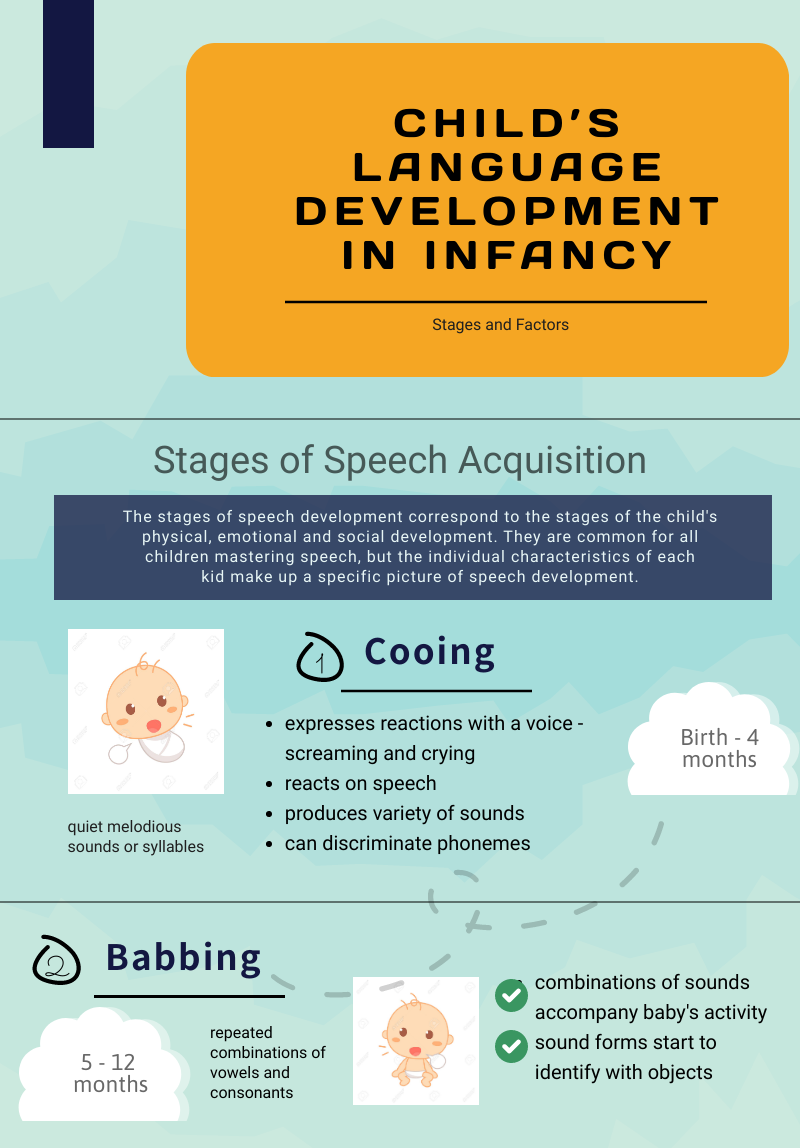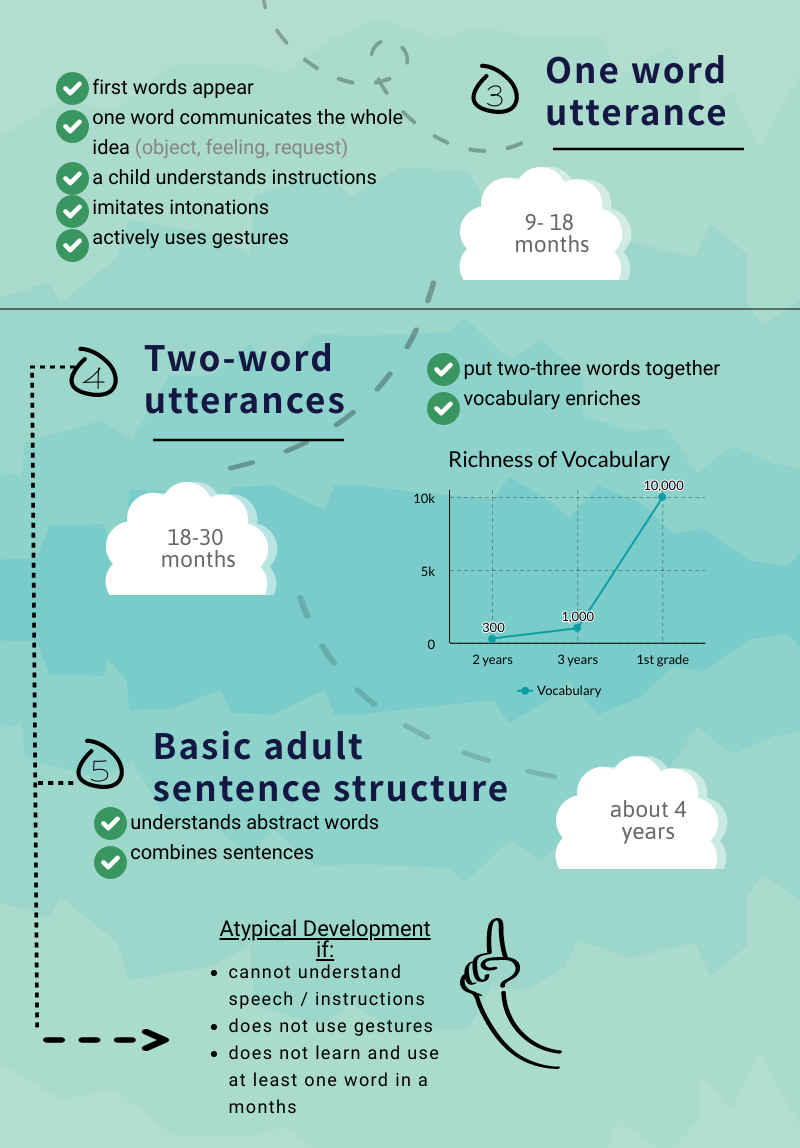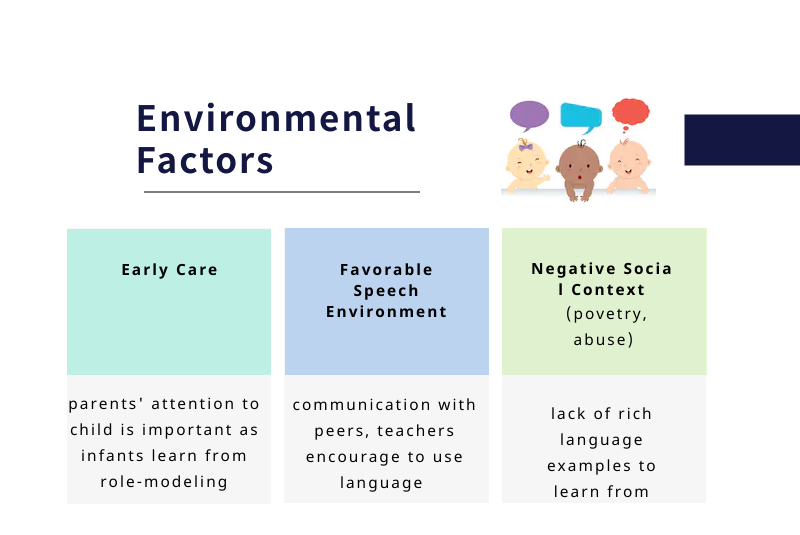The speech begins to develop, starting from the first days of human life. The individual characteristics of each child make up a specific picture of his language development. For example, one toddler out of five will start talking later than peers (American Academy in Pediatrics, 2019). However, some milestones exist corresponding to a child’s physical, emotional, and social development. If the level of language acquisition is within the age group’s capabilities, then such development can be considered successful.
Speech development is essential in infancy, as oral language becomes the basis for a baby to learn to read and write in the future. It is generally accepted that “a child with a language impairment is six times more likely than typically developing peers to experience difficulty with early reading and writing” (Amorsen & Wilson, 2016, p.24). Achievements of oral language mastery such as grammar, vocabulary size, phonological awareness, and decoding skills build a basis for future reading comprehension (Whorrall & Cabell, 2015). It means that the more complex speaking skills are, the more fluent and thoughtful reader the child will make.
How can parents and teachers identify language impairments in early childhood? According to statistics, children having communication difficulties often experience accompanying complications: they avoid communication with peers and teachers, do not participate in classroom and group activities, refuse to respond to teacher’s questions, and sometimes ignore parents’ questions (American Academy in Pediatrics (2019). These might be the aspects signalizing problems with language use in children. Moreover, the following time frames serve as benchmarks for seeking medical care. The kid is silent in the first twelve months or utters the same type of sounds, does not show a reaction to words addressed to them at one year, is not successful in repeating heard words, cannot show an object named at one and a half to two years (Dickinson & Morse, 2019). It can also cause concern if a toddler cannot build simple phrases like “give me an apple” or “I want to drink” by three years.
Environment plays an essential role in language skills development. Children imitate, copy speech, and, subsequently, their vocabulary and language use will depend on the speech environment (Dickinson & Morse, 2019). If the infant is neglected, deprived of communication with parents and other people, there is a high risk of speech impairments. It is essential how much spoken language the child hears every day and how their own attempts to produce sounds and words are responded to (Whorrall & Cabell, 2015). Uncomplicated speech impairments are treated with the parent’s help. It is vital to involve a toddler in communication: parents should engage kids in everyday talks, conversations with “cognitively challenging questions” and elaborated vocabulary, avoid close-ended questions demanding a one-word response (Whorrall & Cabell, 2015, p. 335). It is also important to listen to them properly and exhibit a bright example.
The infant’s speech develops faster and better when adults talk to them a lot, not just talk, but specifically communicate. The speech should be addressed directly to the child for the kid to respond in an accessible form. Parents can continuously inquire about their feelings, ask to comment on their actions at the moment, react to various situations (Dickinson & Morse, 2019). The experts also recommend using books with silly questions and flashcards to motivate speaking (Anthony, 2019). Reading with kids, learning rhymes, memorizing, and singing songs can also boost vocabulary and speech (Amorsen & Wilson, 2016). The child must be in a favorable speech environment, which positively affects language opportunities in the future. Nevertheless, continuous lively interactions with a kid, showing affection, and sharing thoughts on everything around can, on many occasions, guarantee healthy language development.
References
American Academy in Pediatrics (2019). Language Delays in Toddlers. HealthyChildren. Web.
Amorsen, A. & Wilson, D. (2016). Let me talk! The relationship between children’s oral language and early literacy skills. Educating Young Children, 22(1), 23–27. Web.
Anthony, M. (2019) Language and Literacy Development in 3-5 Year Olds. (2019). Scholastic. Web.
Dickinson, D. K., & Morse, A. B. (2019). Connecting through talk : nurturing children’s development with language. Paul H. Brookes Publishing.
Whorrall, J., & Cabell, S. Q. (2015). Supporting Children’s Oral Language Development in the Preschool Classroom. Early Childhood Education Journal, 44(4), 335–341. Web.
Appendix A




